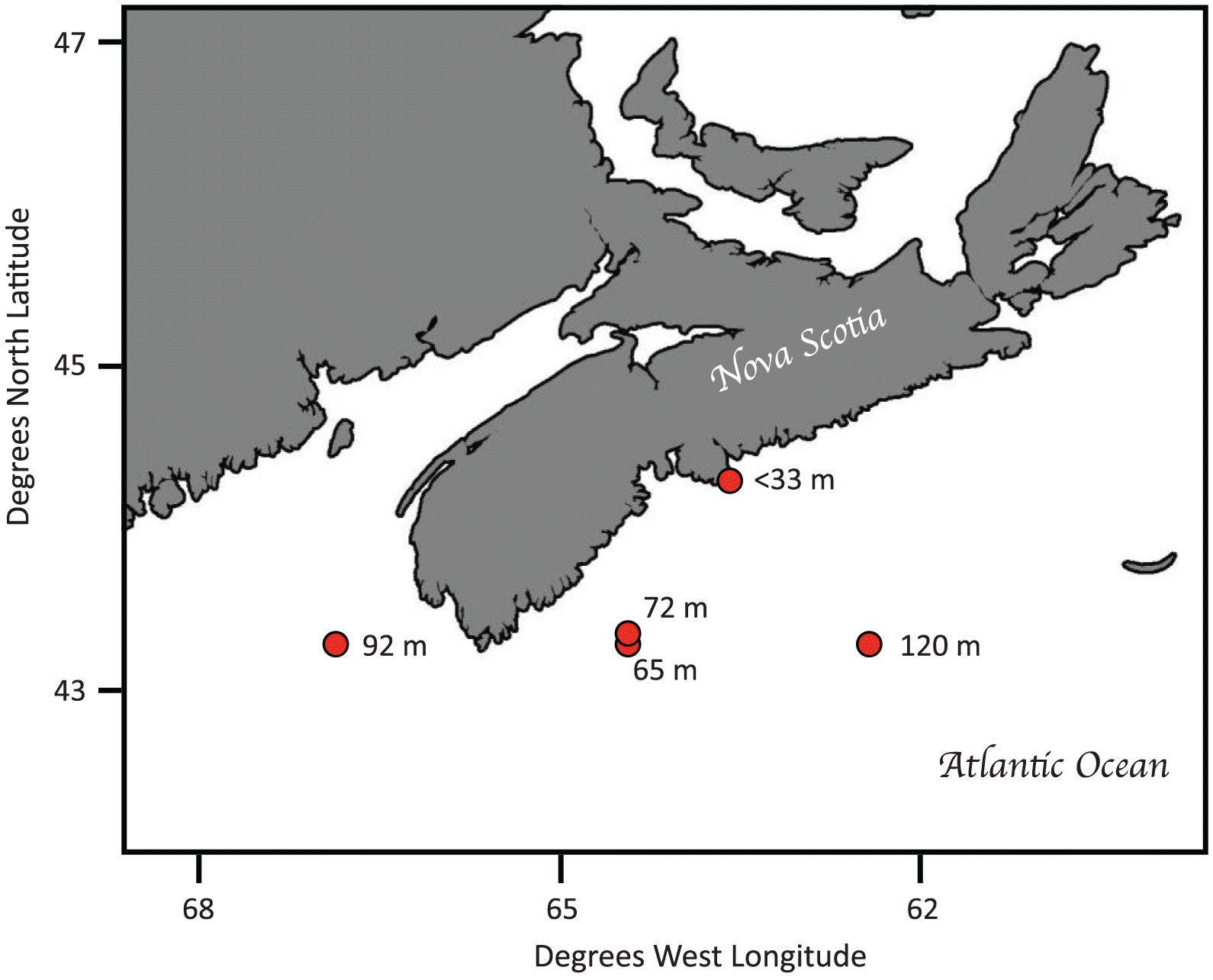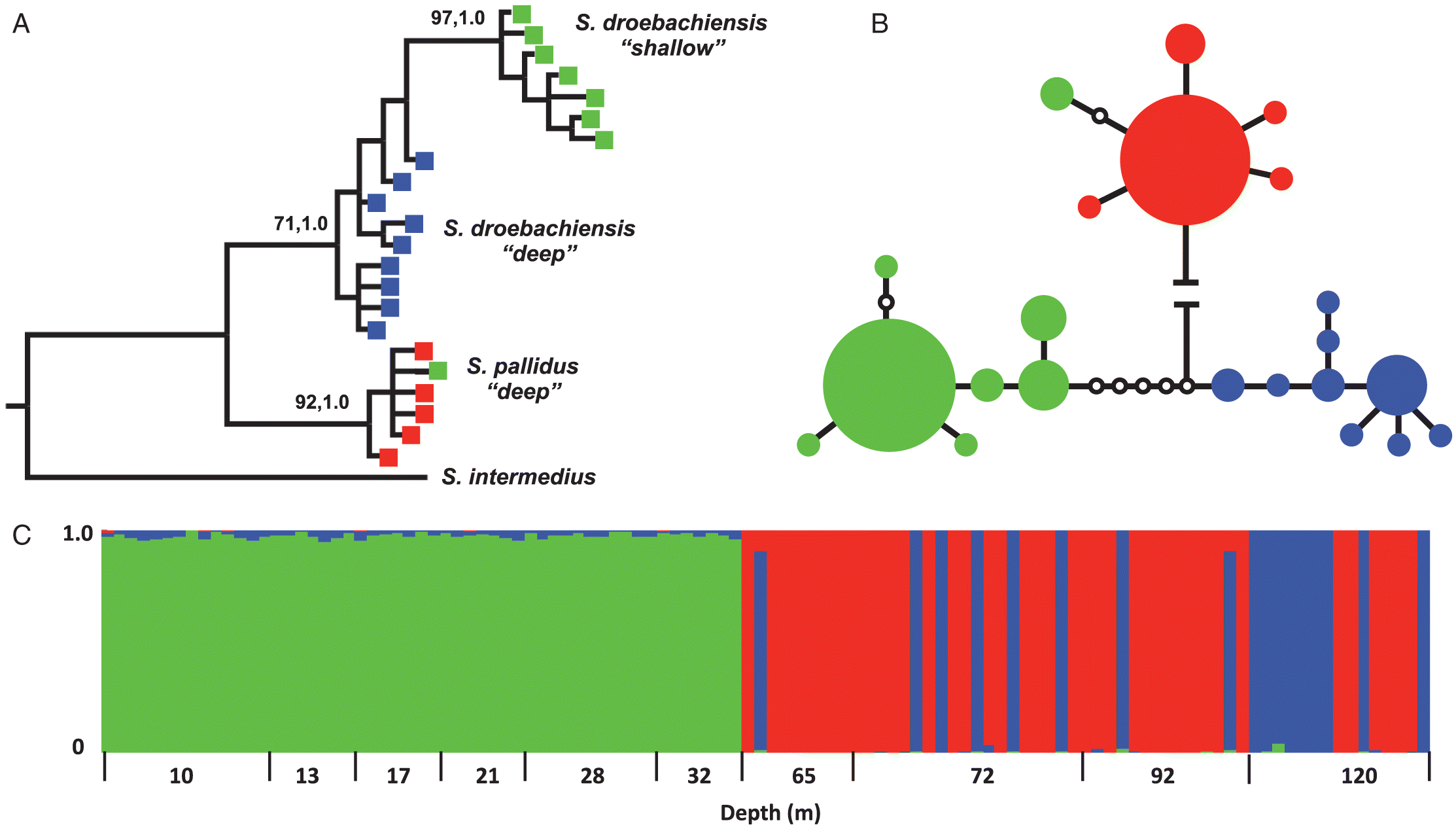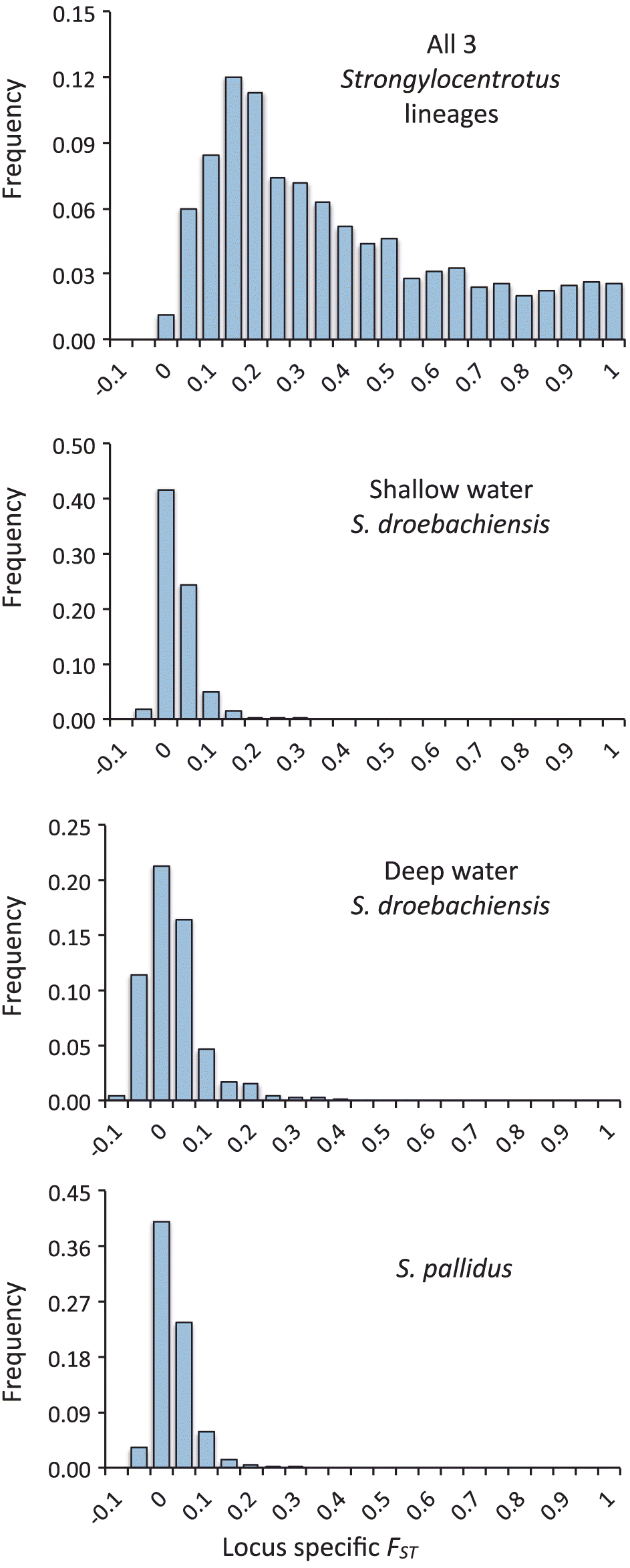Introduction
Broadcast-spawning marine invertebrates offer unique prospects for studying reproductive isolation, because the opportunities for allopatric separation are fewer in the ocean, and both divergent selection along ecological boundaries and the evolution of gamete incompatibilities are expected to be key mechanisms driving speciation in the sea (
Bowen et al. 2013). Genetic studies aimed at assessing the ecological and evolutionary processes that initiate divergence among populations hinge on the capacity to recognize (and target) species of interest, because the mechanisms driving intraspecific diversification can be different from those driving interspecific divergence (e.g.,
Palumbi 1994). Recent studies on marine invertebrates (e.g.,
Vogler et al. 2008;
Ladner and Palumbi 2012;
Pérez-Portela et al. 2013;
Pante et al. 2015;
Warner et al. 2015) have identified cryptic species in what were once thought of as divergent populations. In such cases, unrecognized diversity within or among populations containing cryptic species influences the partitioning of genetic variation among allopatric samples and can bias the estimation of population divergence. Thus, patterns of genetic structure are open to being misinterpreted as a result of restricted gene flow and increased genetic drift while overlooking additional extrinsic and intrinsic factors driving genetic differentiation among species.
Differentiating between intra- and inter-specific diversity in sympatric lineages also provides the opportunity to identify introgressive hybridization when reproductive isolation is incomplete. Recent empirical studies have resurrected ecological factors as a primary driver of marine speciation (
Choat 2006;
Bowen et al. 2013), and the ecological differences between adjacent habitats represent a middle ground between sympatric and allopatric isolation (
Doebeli and Dieckmann 2003). Identifying hybrid zones that form across such habitat disjunctions provides a “natural laboratory” in which we can observe the evolutionary process of speciation. Offspring of mixed ancestries contain different combinations of parental genotypes that are tested by natural selection (
Barton and Hewitt 1985), and the introgression of loci among hybrids will vary with their effect on fitness. Thus, hybrid zones offer important settings for studies of selection, gene flow, and genetic drift, because the introgression of foreign alleles is a direct measure of the degree of reproductive isolation.
Sea urchins have long been a model organism for the studies of developmental biology, and species in the genus
Strongylocentrotus are becoming an increasingly popular in the study of population genetics and evolution (
Addison and Hart 2004;
Addison and Hart 2005;
Addison and Pogson 2009;
Pujolar and Pogson 2011;
Kober and Bernardi 2013;
Norderhaug et al. 2016). Genetic studies of
Strongylocentrotus droebachiensis (Müller, 1776) detected local panmixis but significant population substructure between the east and west coasts of the north Atlantic, where the eastern populations had low genetic diversity at both microsatellite loci and mtDNA sequences (
Addison and Hart 2004,
2005;
Harper et al. 2007). Individuals of eastern descent were detected at low frequency in more diverse western populations, and the patterns of genetic subdivision were interpreted as the result of limited intraspecific gene flow and genetic drift. However, subsequent research on patterns of morphological variation in sperm traits have identified significant differences among populations of
S. droebachiensis, with sea urchins from the northwest Atlantic and Pacific having longer and narrower sperm nuclei than those from the northeast Atlantic (
Marks et al. 2008). Similarly,
Manier and Palumbi (2008) reported that overall sperm morphology (head length, head width, axoneme length, and mid-piece area) was most divergent between the Pacific and the northeast Atlantic, and comparisons of quantitative divergence (
QST) for sperm characters relative to divergence at neutral microsatellite markers (
FST) suggest that directional selection may be accelerating the evolution of sperm traits, especially between the Pacific and northwest Atlantic. Significant divergence in both genetic and morphological characters among allopatric populations across the north Atlantic suggests that lineages of
S. droebachiensis may be distinct (cryptic) species, and the presence of mtDNA lineages from the eastern populations in the west may simply be a result of incomplete lineage sorting and not gene flow per se. Distinguishing between intraspecific gene flow and interspecific lineage sorting in north Atlantic populations of
S. droebachiensis will help identify the relevant scales to which population subdivision is an evolutionarily driver in this system.
In addition to potential for gene flow between the east and west lineages of
S. droebachiensis, patterns of genetic diversity within Atlantic populations of
S. droebachiensis may also be influenced by introgressive hybridization with the congener
Strongylocentrotus pallidus (Sars, 1871).
Strongylocentrotus droebachiensis and
S. pallidus are circumpolar and have overlapping depth preferences, with
S. dreobachiensis typically found in shallow habitats (0–30 m) and
S. pallidus in deeper habitats (>30 m). Mixed aggregations of both species have been observed throughout their range at depths >15 m (
Vasseur 1952;
Swan 1953;
Gagnon and Gilkinson 1994;
Bluhm et al. 1998), and as both species broadcast sperm and eggs, opportunities exist for their gametes to interact in the plankton. However, levels of hybridization and introgression detected in natural populations (
Addison and Hart 2005;
Harper et al. 2007;
Addison and Pogson 2009;
Pujolar and Pogson 2011) are much lower than predicted based on their propensity to hybridize under laboratory conditions (
Strathmann 1981). Analyses of nuclear DNA sequences detected asymmetric introgression (from
S. pallidus into
S. droebachiensis) in approximately 5% of individuals sampled in the northeast Pacific (
Addison and Pogson 2009). Genetic studies of
S. droebachiensis in the northwest Atlantic are consistent with the low asymmetric gene flow of mitochondrial genes from
S. pallidus (
Addison and Hart 2005), but a lack of resolution at nuclear loci (four microsatellites;
Addison and Hart 2002,
2004) makes it difficult to distinguish between incomplete lineage sorting and recent hybridization.
Our goal with this study is to examine northwest Atlantic populations of Strongylocentrotus sea urchins for evidence of cryptic species and hybridization. To do this, we evaluated mitochondrial and nuclear DNA polymorphisms in both coastal populations of S. droebachiensis (10–30 m) and offshore populations of S. pallidus (65–120 m). If contemporary gene exchange occurs between S. pallidus and S. droebachiensis (interspecific hybridization) or among genetically distinct populations of S. droebachiensis (intraspecific gene flow), then patterns of mtDNA haplotype sharing among lineages should correspond to admixture at nuclear loci. Alternatively, if mtDNA haplotype sharing results from incomplete lineage sorting or historical introgression, then we predict limited admixture across the nuclear genome. Finally, the absence of both mtDNA haplotype sharing and admixture across the nuclear genome would suggest complete reproductive isolation among the lineages. Overall, this study contributes to a better understanding of reproductive isolation among Strongylocentrotus sea urchin lineages in the north Atlantic and provides a framework for distinguishing between mechanisms driving intra- and inter-specific divergence.
Discussion
Our main goal was to assess northwest Atlantic populations of
S. droebachiensis and
S. pallidus for the presence of cryptic species and evidence of gene flow among them. Our data reveal a striking pattern of spatial segregation, genetic divergence, and reproductive isolation between two lineages of
S. droebachiensis. Pairwise
FST between shallow- and deep-water populations of
S. droebachiensis was high (0.497,
p < 0.001) and we failed to detect individuals of mixed ancestry using nuclear genetic markers. Shallow- and deep-water populations did not share mtDNA haplotypes, and the average genetic distance between the two mito-groups was 2.3% (K2P). Phylogenetic analysis of mtDNA identified the deep-water lineage as being genetically similar to sea urchins sampled in the northeast Atlantic (11 of the 17 haplotypes are identical to those found in Iceland and Norway,
Fig. S1;
Addison and Hart 2005). These results are consistent with earlier genetic studies in which significant subdivision between eastern and western Atlantic populations of
S. droebachiensis was found for both mitochondrial (
Addison and Hart 2005;
Harper et al. 2007) and nuclear loci (sperm
Bindin:
Marks et al. 2008; microsatellites:
Addison and Hart 2004,
2005). However, in combination with the significant morphological divergence identified in sperm traits (
Manier and Palumbi 2008;
Marks et al. 2008), the patterns of genome wide divergence and lack of hybridization we detected in this study suggest the presence of a cryptic species in north Atlantic
S. droebachiensis. These results indicate that the patterns of significant genetic subdivision and asymmetric gene flow from eastern to western populations of
S. droebachiensis (
Addison and Hart 2004,
2005) may represent some degree of interspecific variation and cannot be strictly interpreted as limited intraspecific gene flow and genetic drift. Because both the eastern and western lineages of
S. droebachiensis have been reported to co-occur in shallow-water populations at higher latitudes in the northwest Atlantic (e.g.,
Addison and Hart 2005), future genetic studies of these populations will provide insight evolutionary mechanisms driving both ecological and reproductive isolation.
Although studies in the Pacific Ocean have detected asymmetric hybridization and introgression from the pale sea urchin (
S. pallidus) into the green sea urchin (
S. droebachiensis) (
Addison and Pogson 2009;
Pujolar and Pogson 2011), our results suggest that northwest Atlantic lineages of these species are reproductively isolated. Divergence at mitochondrial (5.5% K2P distance) and nuclear loci (
FST = 0.474) was high, and the admixture analysis of nuclear loci failed to identify hybrid individuals. We detected
S. pallidus mtDNA haplotypes in two shallow-water
S. droebachiensis individuals (4% of the samples), and this is consistent with the findings of
Addison and Hart (2005), which reports a similar pattern in 3% of samples (
n = 132) from Nova Scotia and Newfoundland. However, limited admixture in the nuclear genome (<5%) in our samples suggests that the shared mtDNA lineages are result of historical gene flow or incomplete lineage sorting, and not recent hybridization.
We detected only weak evidence of hybridization between the deep-water lineages of
S. droebachiensis and
S. pallidus. Although the levels of mtDNA and nDNA divergence were high (4.2% K2P and
FST = 0.467, respectively), our structure analysis identified two deep-water
S. droebachiensis individuals of mixed ancestry whose nuclear genome consisted of ∼10%
S. pallidus. This level of introgression corresponds to a third-generation backcross, indicating that gene flow is contemporary and reproductive isolation between these two species may not yet be complete. Little is known about the spawning ecology of deep-water
Strongylocentrotus sea urchins, but the relatively low frequency of hybrids detected in our deep
S. droebachiensis population (∼12%) and absence of F
1 or F
2 crosses indicate that gene flow between the species is rare. As population densities of sea urchins are generally low in the deep-water habitat of the northwest Atlantic (
Gilkinson et al. 1988), the low frequency of hybrids could be explained by the low probability of heterospecific gametes interacting in the plankton. Alternatively, hybrids may form readily, but a moderate level of post-zygotic selection may act on early life stages (larvae, recruits, and juveniles) to maintain the barriers to gene exchange. More extensive surveys of deep-water populations are required to fully assess the extent to which the
S. pallidus and
S. droebachiensis hybridize throughout their range.
Given that hybrids readily form in laboratory crosses among Pacific (
Strathmann 1981;
Levitan 2002a,
2002b) and Atlantic (
Biermann and Marks 2000) species of
Strongylocentrotus sea urchins, the relatively low levels of hybridization in natural populations we detected in the northwest Atlantic may be due to a variety of pre-zygotic or post-zygotic mechanisms. Like most marine invertebrates, sea urchins broadcast spawn by simply releasing their sperm and eggs into the water column. Habitat or temporal isolation are effective pre-zygotic barriers among broadcast-spawning species (e.g.,
Pernet 1999;
Coppard and Campbell 2005), but for sympatric species that spawn simultaneously, reproductive barriers may largely depend on the compatibilities of their gametes (
Palumbi 1994;
Coyne and Orr 2004). In the Pacific Ocean,
S. droebachiensis co-occurs with
S. purpuratus and
Mesocentrotus franciscanus (nee.
S. franciscanus;
Kober and Bernardi 2013), all of which vary in their egg traits and susceptibility to fertilization under sperm limitation (
Levitan 1993,
2002a,
2002b).
Strongylocentrotus droebachiensis typically has a lower population density and produces eggs that are easily fertilized by both conspecific and heterospecific sperm (
Levitan 2002a,
2002b). However, in the north Atlantic,
S. droebachiensis is the only species of sea urchin in the shallow subtidal (<30 m) where population densities can reach 400 m
−2 (
Scheibling and Hennigar 1997). High sperm density in these populations can result in high variance in reproductive success caused by polyspermy (
Levitan 2004,
2005), leading to sexual conflict as males are selected for fast fertilization and females are selected to prevent polyspermy by reducing fertilization rates (
Levitan 2004;
Levitan and Ferrell 2006;
Levitan et al. 2007;
Levitan and Stapper 2010). Under this scenario, the eggs of
S. droebachiensis in northwest Atlantic populations may have co-evolved mechanisms that indirectly reduce the susceptibility to heterospecific sperm and thus prevent hybridization.
The rapid evolution of gamete recognition molecules has long been considered an important driver of speciation in Echinoderms (
Vacquier 1998;
Palumbi 2009;
Lessios 2011;
Vacquier and Swanson 2011). Both proteins and carbohydrates (sulfated polysaccharides) coating the sperm and eggs mediate gamete interactions in the plankton and are involved in sperm competition and mate choice (
Biermann et al. 2004). Positive selection at the coding regions of some of these genes, including sperm
Bindin (e.g.,
Biermann 1998), correlates with the strength of reproductive isolation between species (
Zigler et al. 2005). If the divergence within
S. droebachiensis corresponds with the invasion of the east and west coasts of the Atlantic followed by population expansion throughout the ocean basin, then is it possible that continued selection at gamete signaling and recognition molecules continues to drive reproductive isolation (i.e., reinforcement selection;
Lessios 2011). Patterns of divergence at sperm
Bindin within Atlantic populations of
S. droebachiensis support the importance of reinforcement selection in this system, but future studies are needed to link the function of genotypes with reproductive success and the presence of hybrids throughout the ocean basin.
Our failure to detect hybrids between
S. pallidus and
S. droebachiensis in adult sea urchins sampled from the shallow-water coastal habitat may also be a result of strong post-zygotic selection on individuals of mixed ancestry. As our sample site in Nova Scotia is close to the southern range limit of coastal populations of
S. droebachiensis, decadal and seasonal variation in salinity (
Breeze et al. 2002;
Russell 2013;
Bundy et al. 2014) may intensify the ecological gradient along which the shallow and deep lineages are adapted.
Russell (2013) reported that over an eight year period the coastal salinity in New Hampshire frequently drop below 26‰ in March and April, with the lowest recorded salinity being 15‰. Laboratory studies have demonstrated that
S. droebachiensis is one of the most tolerant echinoderms to hyposalinity (
Russell 2013).
Roller and Stickle (1985) showed that in the Pacific, larvae of
S. pallidus failed to develop, and cultures experienced 100% mortality at salinities below 27.5‰. In contrast, although cultures of
S. droebachiensis developed slowly at salinities ≤22.5‰ and below, survival was 100% at salinities as low as 20‰. In addition, hybrids generated by crossing female
S. droebachiensis with male
S. pallidus experienced 100% survivorship at salinities as low as 22.5‰.
Himmelman et al. (1984) showed that
S. droebachiensis collected in the Gulf of St. Lawrence tolerated salinities as low as 14‰. However in the same study, individuals collected from Nova Scotia experienced complete mortality when exposed to the same conditions, indicating that the geographical origin and possibly the genetic composition of populations contributed to the ability to tolerate hyposmotic stress. As both pure and hybrid
S. pallidus are more susceptible to salinity <22.5‰, it is possible that seasonal variation in salinity could either limit the dispersal of hybrid larvae produced in overlapping populations in deeper habitats or impose strong post-settlement selection on newly metamorphosed recruits or juveniles. Future studies should aim to evaluate these ecological factors as primary drivers of both geographic range limits of and genetic divergence among north Atlantic lineages of
Strongylocentrotus sea urchins.
Our results are consistent with a recent barcode survey of 145 Canadian Ecninoderm taxa by
Layton et al. (2016), in which the authors detected 23 lineages that could not be identified to the species level. Of these individuals were two samples of
Strongylocentrotus from the Arctic, and analysis of this confirms that these individuals cluster with others from the deep-water/northeast Atlantic lineage (
Fig. S1). This finding suggests that the cryptic species is widespread throughout the Atlantic basin, segregating in sympatry with shallow-water
S. droebachinesis at northern latitudes but being restricted to deeper habitats at southern latitudes. It is possible that the range and habitat limits are driven by similar ecological conditions discussed above, and future surveys of
Strongylocentrotus populations throughout the Atlantic are required to better detail the species’ distributions.




